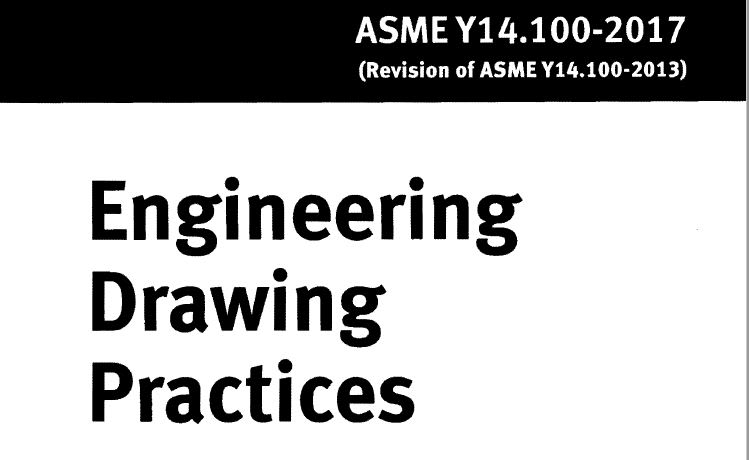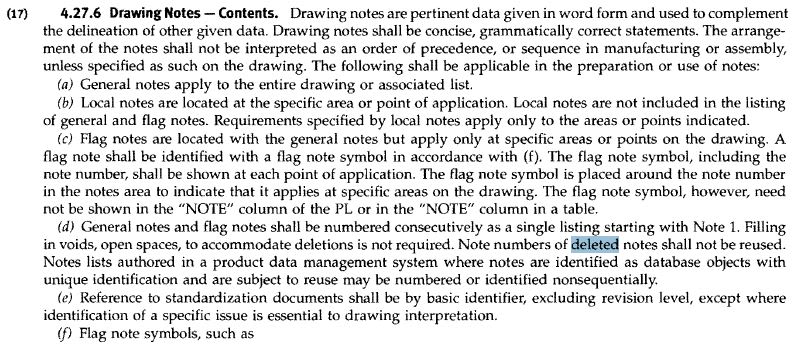JoeD1020
Military
- Aug 24, 2022
- 3
thread1103-367803
Greetings,
I have long used this forum to sanity check and dig up which standard I need to dig into to justify my case to whomever is critiquing my drawings or my reviews. So first, thank you all so much!
This is my first post, so I hope I do not mess it up. If I do, apologies and I will fix if able!
Second,
When I was a fresh grad, I was taught by seasoned drafters that when you remove a note from a drawing, you leave the number and put "DELETED" in order to provide sanity to people reading the next revision. I.E no confusion over why the notes are going 1 ...2...4...5...6..9.. etc. They beat what was considered best practice into me with red pens and I am grateful for it. (Most of them coming from a history working at UTC or its sold off branches).
I know in old paper-space days it was for more practical reasons that come with changing that much of a document, but in digital-space the deletion of a note entirely seems trivial to some at my workplace, who argue that we delete the note entirely and simply skip the number, much like how we do already for the parts list.
All I can find is in ASME Y14.100 4.27.6(d) talking about not re-using the same note number, which everyone at my company agrees with, but there is no mention of leaving the number there and adding the words "DELETED" or similar. The closest I can see is if we stretch the requirement of the notes being numbered consecutively.
So my question is if there is a hard written rule on this matter, or if the quote above is all there is on the matter? I didn't see anything directly helpful in 14.35 for revision control either, but my copy is from '97 so its possible the latest has mention somewhere.
Is this a case of "I know this is right because I was trained that way" and not actually having a written standard to back it up, or is it actually buried in ASME somewhere and I just have not found it?
Thank you in advance.
-Joe
Greetings,
I have long used this forum to sanity check and dig up which standard I need to dig into to justify my case to whomever is critiquing my drawings or my reviews. So first, thank you all so much!
This is my first post, so I hope I do not mess it up. If I do, apologies and I will fix if able!
Second,
When I was a fresh grad, I was taught by seasoned drafters that when you remove a note from a drawing, you leave the number and put "DELETED" in order to provide sanity to people reading the next revision. I.E no confusion over why the notes are going 1 ...2...4...5...6..9.. etc. They beat what was considered best practice into me with red pens and I am grateful for it. (Most of them coming from a history working at UTC or its sold off branches).
I know in old paper-space days it was for more practical reasons that come with changing that much of a document, but in digital-space the deletion of a note entirely seems trivial to some at my workplace, who argue that we delete the note entirely and simply skip the number, much like how we do already for the parts list.
All I can find is in ASME Y14.100 4.27.6(d) talking about not re-using the same note number, which everyone at my company agrees with, but there is no mention of leaving the number there and adding the words "DELETED" or similar. The closest I can see is if we stretch the requirement of the notes being numbered consecutively.
(d) General notes and flag notes shall be numbered consecutively as a single listing starting with Note 1. Filling
in voids, open spaces, to accommodate deletions is not required. Note numbers of deleted notes shall not be reused.
So my question is if there is a hard written rule on this matter, or if the quote above is all there is on the matter? I didn't see anything directly helpful in 14.35 for revision control either, but my copy is from '97 so its possible the latest has mention somewhere.
Is this a case of "I know this is right because I was trained that way" and not actually having a written standard to back it up, or is it actually buried in ASME somewhere and I just have not found it?
Thank you in advance.
-Joe


